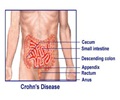Polyps have successfully been removed in millions of people each year during colonoscopies.

A UCLA team of surgeons and gastroenterologists has been performing a new, minimally invasive procedure to remove large and hard-to-reach polyps while keeping the colon intact. The procedure, which combines two minimally invasive techniques, has currently been performed at only a handful of medical centers in the United States.
In the June issue of the journal Surgical Endoscopy, the UCLA researchers present their experiences using the new technique — known as CELS, for combination endoscopy and laparoscopy surgery — and offer the first comparison of the new technique and standard surgery.
"The CELS approach combines the best of minimally invasive techniques and may prove to be a viable option for select patients," said senior author Dr. James Yoo, an assistant professor of surgery and chief of the colon and rectal surgery program for the UCLA Health System and the David Geffen School of Medicine at UCLA.
For the study, the team compared outcomes for five patients who underwent the new procedure with outcomes for nine patients who received standard surgery to remove suspicious polyps between August 2008 and October 2012.
The new technique starts out like a colonoscopy, with a gastroenterologist advancing an endoscope inside the colon. The endoscope, a device with a small video camera and a light attached, lets doctors look inside the body cavity. Once a polyp is in sight and the gastroenterologist is ready to remove it, the surgeon uses minimally invasive surgical tools, inserted through two to four tiny incisions in the abdomen, to carefully maneuver and manipulate the colon, allowing the gastroenterologist better access to the polyp.
Advertisement
Once the polyp is removed, it is immediately taken to the lab for analysis to determine if it's benign or cancerous, while the team and patient wait in the operating room. The analysis takes about 30 minutes. If the polyp turns out to be cancerous, the team proceeds with the standard surgery to remove the affected portion of the colon.
Advertisement
The procedure time and hospital stay were shorter with the new procedure, the researchers found. Operating time averaged 159 minutes, compared with 205 minutes for standard surgery, and the median hospital stay was one night with the new procedure and five nights with standard surgery.
"The majority of patients in the study had a benign polyp," Yoo said. "We found that the new procedure can be performed safely with outcomes that compare favorably with standard surgery for these select patients."
In the majority of the CELS cases, findings from the quick lab analysis were accurate. However, one patient's final pathology report, which came back a week later, showed that the polyp was cancerous, so that patient was scheduled for standard surgery.
Yoo noted that in the future, newer imaging methods and lab analysis may make it easier to differentiate between a benign and malignant polyp.
"Although this is a small study with one institution's experience, newer technology is helping doctors raise the bar and offer more minimally invasive procedures with less down-time and trauma for the patient," said Dr. Eric Esrailian, co-chief of the division of digestive diseases for the UCLA Health System and the Geffen School of Medicine, who was part of the UCLA team.
Physicians note that patients who successfully undergo the CELS procedure still require follow-up endoscopic evaluation and that surgery is still the standard treatment for cancer or cancerous polyps — or if the polyp cannot be removed endoscopically even with the CELS technique.
The next step in research, according to the UCLA team, is a multi-institutional study to further examine use of the CELS approach to better characterize its impact on surgery.
Source-Eurekalert














